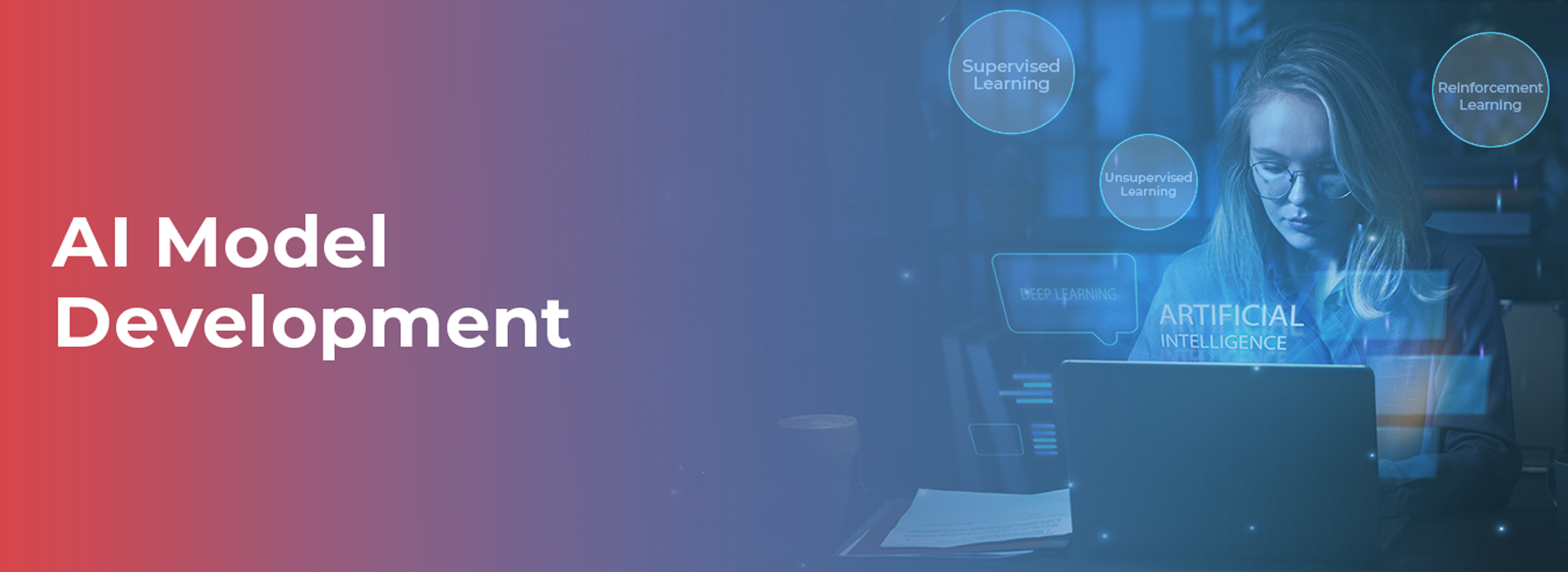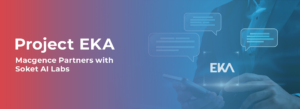Future of Tech with AI Model Development
Artificial Intelligence (AI) has transformed the way we approach innovation. By enabling machines to learn, reason, and make data-driven decisions, AI models are rapidly becoming the core of many advanced technologies. From startups disrupting the market to established enterprises reimagining operations, the importance of AI model development cannot be overstated.
This blog aims to demystify AI model development, explaining its processes, challenges, and real-world applications. Whether you’re an AI enthusiast, a tech visionary, or a startup founder, this guide will explore how you can leverage AI to drive innovation.
What Is AI Model Development?
The development of an AI model involves formulating computer programs that achieve human reasoning processes. They act as the controlling mind for advanced technologies, automating processes and providing intelligent solutions for various industries.
Types of AI Models

AI models vary based on the task they are designed to perform. Here are the most common types developed today:
- Supervised Learning Models – Used for predictive tasks, such as fraud detection and recommendation systems.
- Unsupervised Learning Models – Designed for data clustering, commonly seen in market segmentation and customer profiling.
- Reinforcement Learning Models – Used in dynamic environments like robotics and automated trading.
- Deep Learning Models — These are at the forefront of image recognition and NLP breakthroughs.
Leveraging this model helps businesses enhance customer satisfaction, improve efficiency, and innovate into new markets.
How AI Models Are Developed
Constructing an AI model involves many interrelated steps, necessitating substantial skills, modern tools, and a comprehensive plan. Below find a bulletproof guide to the development process:
1. Define the Objective
Start by identifying the problem your AI needs to solve. Whether it’s optimizing inventory, automating a chatbot, or analyzing large-scale data, a clear objective directs your efforts.
2. Data Collection
AI depends on data. Collect large, high-quality datasets relevant to your objectives. Ensure the data is clean, labeled, and structured to set your model up for success.
3. Data Preprocessing
Raw data is messy. Preprocessing involves cleaning, normalizing, and transforming data into a usable format for machine learning algorithms.
4. Building the Model
Developers choose the algorithms and frameworks suited to the specific task. This step may involve supervised or unsupervised learning, depending on the business need.
5. Training and Testing
During training, the model learns from the data using established patterns. Testing follows, providing insights on its effectiveness by identifying areas for improvement.
6. Optimization
The model is fine-tuned to improve its accuracy and reliability. This iterative phase ensures the technology meets intended quality benchmarks.
7. Deployment
Once tested and optimized, the model is integrated into real-world applications. Deployment is where businesses start realizing the impact of their AI systems.
8. Monitoring and Maintenance
AI evolves over time as it interacts with users and data. Regular monitoring ensures the model remains accurate, relevant, and bias-free.
Tackling Challenges in AI Model Development
Although groundbreaking, AI model development comes with its own set of challenges. Here are a few—and how to overcome them.
1. Lack of High-Quality Data:
Data scarcity or inaccuracies can undermine your model. Combat this by leveraging synthetic data generation or reaching out to data partners.
2. Computational Costs:
Training AI models requires significant computational power and resources. Cloud-based platforms such as AWS, Google Cloud, and Azure can help manage the costs effectively.
3. Bias in Algorithms:
Bias in data leads to skewed outcomes, often harming inclusivity and accuracy. Perform bias audits and implement fair AI frameworks to ensure neutrality.
By proactively addressing these hurdles, developers can harness the true potential of AI.
Effects of Artificial Intelligence Models In The World
Automation of workflows in combination with advanced decision-making has AI models to thank. The integration of AI into business models has helped differentiate companies in their sectors. As a case study, consider the following top five businesses that took advantage of AI models:
- Magence- A leader in NLP (Natural Language Processing) technology that enhances communication and provides valuable customer insights.
- Open AI- Famous for the creation of GPT based models that powerfully drive chatbots and other text generation applications.
- DeepMind- In the forefront of Innovating predictive and reinforcement learning applications for healthcare and energy industries.
- UiPath- Leading in use of AI powered robotic process automation, or AI RPA, to automate menial and repetitive work.
- NVIDIA- Designs frameworks for deep learning AI systems that encourage the development of self-driving vehicles and video games.
These success stories highlight the value of AI model development across sectors like customer service, marketing, logistics, and more.
Leveraging AI Model Development for Startups
Startups, in particular, can greatly benefit from integrating AI models into their business strategy:
- Enhanced Efficiency – Automate routine tasks, saving time for innovation.
- Competitive Edge – Distinguish your brand with AI-driven personalization and unique offerings.
- Scalability – Use AI insights to adapt quickly, meeting fluctuating demands with ease.
AI is no longer limited to enterprise giants. Startup-friendly tools, such as Magence’s modular solutions, make AI accessible and scalable for newer businesses.
The Future of AI Model Development
AI continues to evolve with exciting trends shaping the industry.
Emerging Trends to Watch
- Explainable AI (XAI): Focused on transparency, making AI decisions easily interpretable.
- Federated Learning: Collaborates on decentralized data while maintaining privacy.
- General AI (AGI): Researchers are edging closer to creating more human-like, versatile AI systems.
With advancements like these on the horizon, the future of AI is limitless.
The Technology Innovator’s Next Step
Artificial Intelligence is not just a mere tool anymore; it’s an essential asset. AI development is becoming an integral part of every aspect ranging from the transformation of entire industries to the development of consumer intelligent products.
Startups and novel technology entrepreneurs need to urgently address the question of how applying AI models can fundamentally change their business processes, increase the scale of their offerings, and improve customer value.
Looking for expert AI development? See how Magence and other leading tech companies can help you unlock your organization’s AI potential. Who knows—your next big innovation might just be one algorithm away.
FAQs
Ans: – Depending on the model’s complexity and purpose, the amount of time needed will shift. In general, it takes weeks to months on average to fully develop, test, and deploy a model.
Ans: – Some of the most productive sectors that use AI models are healthcare, finance, retail, manufacturing, and even marketing.
Ans: – Proficient use of programming languages such as Python, mathematics, and machine learning along with knowledge of data science constitutes the critical skillset needed.
You Might Like
February 28, 2025
Project EKA – Driving the Future of AI in India
Spread the loveArtificial Intelligence (AI) has long been heralded as the driving force behind global technological revolutions. But what happens when AI isn’t tailored to the needs of its diverse users? Project EKA is answering that question in India. This groundbreaking initiative aims to redefine the AI landscape, bridging the gap between India’s cultural, linguistic, […]
March 7, 2025
What is Data Annotation? And How Can It Help Build Better AI?
Spread the loveIntroduction In the world of digitalised artificial intelligence (AI) and machine learning (ML), data is the core base of innovation. However, raw data alone is not sufficient to train accurate AI models. That’s why data annotation comes forward to resolve this. It is a fundamental process that helps machines to understand and interpret […]
March 6, 2025
Vertical AI Agents: Redefining Business Efficiency and Innovation
Spread the loveThe pace of industry activity is being altered by the evolution of AI technology. Its most recent advancement represents yet another level in Vertical AI systems. This is a cross discipline form of AI strategy that aims to improve automation in decision making and task optimization by heuristically solving all encompassing problems within […]
March 5, 2025
Use of Insurance Data Annotation Services for AI/ML Models
Spread the loveThe integration of artificial intelligence (AI) and machine learning (ML) is rapidly transforming the insurance industry. In order to build reliable AI/ML models, however, thorough data annotation is necessary. Insurance data annotation is a key step in enabling automated systems to read complex insurance documents, identify fraud, and optimize claim processing. If you […]


 Previous Blog
Previous Blog







